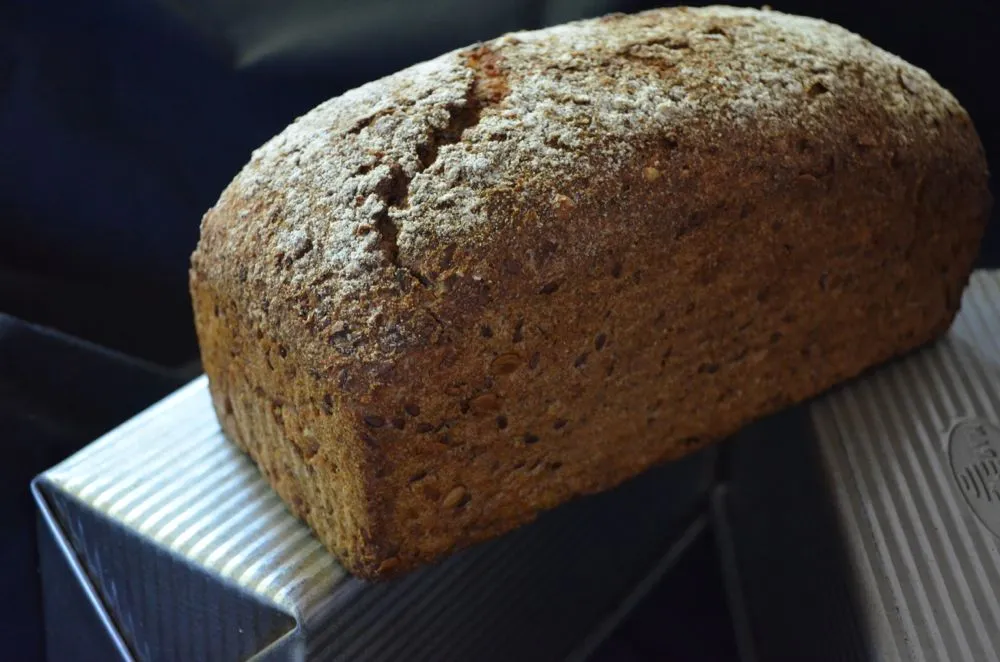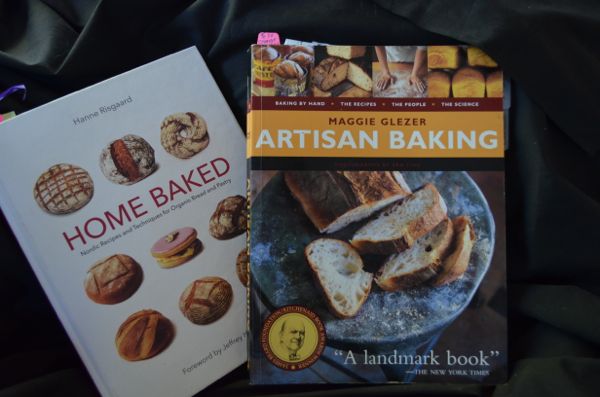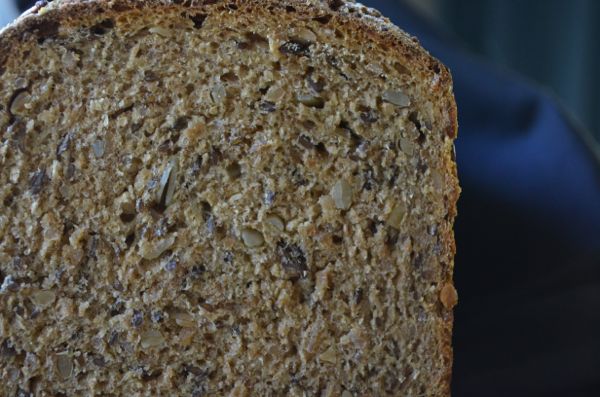

My latest baking obsession challenge has been with what I label as the dense Northern European type of loaves. The kind of loaves that are tall, moist and that last for ages without drying out. I do not mean to offend any Northern Europeans by labeling all of their breads as this type of loaf but I know not how else to describe, in words, how they differ from the other types of breads that I bake. All the formulas I have thus run across are from Russia, Germany, Sweden, Finland, Norway, and Denmark though I know there are many other similar formulas from other countries as well.
That being said….I have baked these loaves on and off for several years now. I got my feet wet when I was enticed by ananda's Borodinsky breads. When I would bake them people loved them but they were not a regular on my 'to bake' list because I simply did not feel confident in the results I was getting with specific hydration levels, baking times and baking temps. Last Fall I got pulled into hanseata's challenge of creating a whole grain loaf which did turn out very nicely but I still did not feel confident with the issues I have expressed above.
This year I decided to embark upon solving those 'problems' and thus began my baking frenzy. I found the formula I wanted to replicate in Maggie Glezer's 'Artisan Baking' and I combined it with a fermentation time line and method I found in Hanne Resgaard's book 'Home Baked'.

This is the result of which I am well pleased. I found the baking times and temps. I am now comfortable with when using my Cadco countertop oven (Convection) which are;
Pre heat 425°
Load covered loaves and reduce heat to 350°
Bake covered for 90 minutes.
Uncover and bake 15 minutes at 350° followed by 15 more minutes at 325°
Another issue I was faced with was that of really hard and dark crusts despite baking temps. Luckily it was solved when another baker told me he uses canola oil on his pans when baking these types of breads rather than butter. Made all the difference in the world.
I know I will have to adjust times etc. when I bake in my kitchen Electrolux wall oven but, at least for now, I feel much more confident when I sit down to formulate one of these kinds of breads for a future bake.
A long time in the works but well worth all the effort as they are breads that people around here love to eat.
- Janetcook's Blog
- Log in or register to post comments
Beauty of a bread Janet,
I do have the "Home Baked" which I've read and continue to read through often but still haven't tried any formulas. i think it's a very different style than my own that keeps me from taking the plunge. But her formulas and breads do look wonderful. This bread you've made looks amazing. My pullman pans won't hold oil as they are very non stick so i use just a touch of butter but I'm sure to wrap the loaves in plastic to help soften the crust and it works a charm. I've heard others will lightly oil the plastic and then warp the loaves. Never tried this.
Anyway Wonderful baking and a lovely new variety you can offer
Cheers
Josh
Hi Josh,
I encourage you to take the plunge into some of her recipes. The Pear and Sourdough is very nice.
I have found that her recipes fit in with whatever method I use to mix and ferment my doughs. In the past I would convert recipes to use with my whole grains and prepare them with my usual bread baking routine but with this loaf I wanted to try out the method which she uses for the dense ryes in the book; mix followed by a short bulk ferment then shaped and put into the refrigerator for anywhere from 12-24 hours. This loaf did not require a lot of attention so, on days when I double up my bakes, having a relatively easy dough to manage is nice.
Glad to know I am not the only one who reads through bread books a lot before actually baking anything from them. :*)
Thanks for your kind words.
Janet
Sadly, we don't bake it often as I am the only one who eats it and it does last forever in the fridge and freezer. I too spray the pan with a light coating of canola oil. Works every timke to get the bread out and the crust does soften nicely as it ages under wraps for a couple of days. Your example is a wonderful one as usual. Can't help but like all the goodies inside this hearty healthy loaf. Did you put YW in it? This is the reason i keep YW around besides replacing commercial yeast in recipes - for breads just like this and pumpernickel, It really opens the crumb up and keeps it moist too.
Well done and Happy baking Janet.
Hi Mr.D,
Thank you for your kind words. I wish the crusts on my 'experimental' loaves would have softened up with time but we are talking hard and burned…..really hard and a danger to ones teeth.
The ingredient list is a bit long but still cannot compare with all of the goodies you manage to fit into a loaf. This one has 12% YW which is all used in the whole wheat leaven.
Take Care,
Janet
Janet, this is a beauty! I'm not yet confident enough to have a go at these breads, so this is a real inspiratiom, maybe it's time! I grew up on the Austrian seed, dinkel and rye breads and there's nothing quite like these breads to warm one's soul! Must taste delicious, on its own or with just about everything. Thanks for egging me on to give it a try!
Thank you for your praise of this loaf. I wasn't confident either hence the 3 year wading into it slowly method and now I realize that these breads are really a lot easier to make than 'normal' loaves since proper kneading isn't really an issue. They are more or less simply mixed until the all the ingredients are incorporated and then left to rise slowly by themselves.
The tricky part for me was the baking times, temps. and moisture content that were so different. What really spurred me on was when I baked one about a month ago just to see what would happen and my 18 year old son proclaimed it as his 'favorite loaf ever'. (His previous favorite loaf was my Honey Whole Wheat….the exact opposite of this loaf so I was taken by complete surprise.) That loaf had a crumbly crumb which was what I set off to correct which triggered all of the other things I had problems with which were what was hindering me from baking these more often. Now I don't feel that hesitancy any longer.
I do hope you try one one of these. The combination of grains and seeds etc are endless once you have the 'base' down.
Take Care,
Janet
A big thumbs up from me, Janet. These are the types of breads I'm most fond of---the dense, nutritious, flavourful loaves that can satiate your hunger for hours. Really wish I can work with whole grains, but you're aware of my situation.
Keep those delicious breads coming,
Zita
Hi Zita,
Your 'thumbs up' means a lot to me. I know your eye for breads :*)
I also know the frustration of not having the grains you like readily at hand. You do a phenomenal job with sourcing flour for your breads. I am always inspired by your determination to make the best for the people you serve.
If postage didn't cost so much I would love to send you a loaf. You will just have to move closer :*)
Take Care,
Janet
I'm also very intrigued with these breads - nice work.
In my pursuit of Danish rugbrot, I ran into many recommendations to wrap the cooked loaves in plastic wrap, even while very slightly warm, to soften the crust while they sit for a day or two after baking. I was a bit skeptical at first, but it worked nicely here:
Some general tips or keys to success you have found with your Finnish Rye?
Your loaf is a beauty! Thanks for posting the photo. Crust and crumb look right just right.
My crusts that were dark were beyond the 'plastic wrap in a bag for a day or two.' They were burnt beyond the point that my favorite bread recipient who adores 'burnt' commented that the crust was indeed too hard….A combination of the butter used on the pan and baking temps that were too high and too long. (I initially tried starting the loaves off at 475° for a bit and gradually dropping the temp. down to 350° where I let them bake for about 90 minutes. The 350° for most of the bake works the best thus far plus using canola oil.
Thanks for commenting and for posting the photo of your excellent loaf. I know a picture is worth a thousand words especially where a loaf of bread is concerned.
Take Care,
Janet
Janet, may I ask which Cadco model you are using, are you satisfied with the performance and how energy efficient it is? Does it throw off a great deal of heat?
Thanks,
I have the XAF −113 and have been more than pleased with it for my purposes as a home baker. It is a work hires and runs without complaint. It is a breeze to keep clean too.
I can't comment on energy efficiency - no way to figure it out with a before and after with our electrical bills since they change all the time depending on who is home when.
Varda may be able to give you better specifics on energy efficiency as she has a larger model and bakes a larger volume of breads than I do.
Janet
Janet, Very nice. Looks like you could eat a slice and be all set for lunch. Have never tried anything like this. Inspiring! -Varda
Hi Varda,
Thank you. You are one of the inspirations for this loaf as it is similar to the Borodinsky Rye. It was one of your posts on that bread that got me dabbling a bit more seriously - especially with the malted rye, a couple of winters ago. I move slowly but now I think I have finally worked out the quirks I was having. I am baking more of these loaves along with my 'usual' loaves since the mixing method works in nicely - allows me to double up on days when I want to.
So, thanks for being a part of this loaf!
Take Care,
Janet